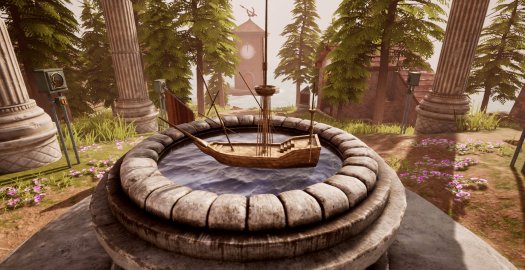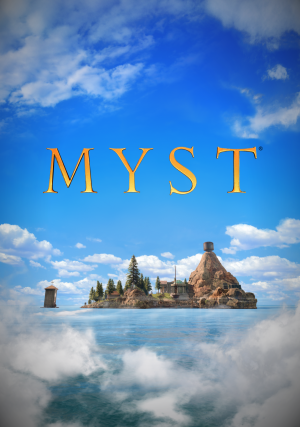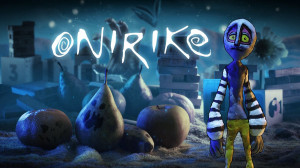Review for Myst (2021)

Whether you are in the “Myst ruined adventure games” or “Myst revolutionized adventure games” camp, there is no denying the huge impact Cyan’s 1993 classic had on the gaming community. Nothing like it had come before, and the tagline “It will become your world” rang true as many players found themselves totally immersed in its stunning environments across many hours of exploration. It made people go out and buy CD-ROM drives just so they could play this one game. Some regretted doing so, mind you, turned off by the deliberately obtuse design and challenging puzzles they encountered. With the subsequent release of Myst – Masterpiece Edition and realMyst, that original slideshow-style version was enhanced and expanded and then moved into the realm of full 3D, seemingly leaving little room to iterate further. Then along came virtual reality, opening up a whole new horizon that has now been reached in 2021. If you have the supported VR hardware you are in for an entirely new Myst experience, but even if you don’t, the flatscreen version significantly raises the ante in terms of graphics and audio, making this the definitive edition that every puzzle-adventure game fan should play.
As a huge fan of the franchise, I was looking forward to playing the latest rerelease using my Oculus Rift S headset. I have played every game in the series, even dipping my toe into the short-lived online experimental waters called Uru. I dusted off my original notes made back in 1994, which include a complete transcription of all the books in the Myst library, along with detailed maps and meticulous observations made while playing. I could have used these notes once again if I had played the “Classic (1993 MYST)” mode which preserves the original puzzle clues, but instead I chose to use the “Randomized” option, which changes certain clues for each new game. Both DirectX 11 and DirectX 12 video is supported, so if you have a slightly older graphics card, or an operating system that does not support DirectX12, you can still play without the need for a potentially costly upgrade, though the hardware demands are higher than a traditional adventure to see it in all its glory.
As in the original game, you start by linking to a mysterious island via a book dropped through a fissure by an unknown person. There is no indication of who you are but it doesn’t really matter, as the entire point of the game is to engage in abundant exploration and puzzle solving. As you wander around the titular island, you will stumble upon a library that contains a shelf of books and pictures on the walls. There you’ll discover a blue book and red book sitting on mantles opposite one another, each with a loose page beside it that you can insert. When you do, you will meet the two brothers trapped in these books – Sirrus and Achenar, sons of a man named Atrus. Both of them claim to be wrongfully imprisoned, and they implore you to free them by collecting more pages to add to their books. To accomplish this, you must figure out how to travel to four different realms via more linking books like the one that brought you here. The details of each world (or “Age” as they’re referred to) are described elsewhere in the library, and it is important to read each relevant book and make appropriate notes to help you on your journey. When adding each newly discovered page to their respective books, you will learn more about the plight of the brothers, and ultimately need to decide which of them to believe, setting the stage for different possible outcomes at the end.
You’ll acquire clues on how to unlock each linking book via the library tower, in conjunction with certain marker switches scattered around Myst Island. You can explore the other worlds in any order you like; each is very different and makes for diverse gameplay. The Mechanical Age, consisting of a central fortress structure with a circular rail surrounding it, allows you to visit two smaller islands by rotating along the rail. Once you collect the red and blue pages there, you need to discover the codes (and the linking book) to return to Myst Island. The Channelwood Age features treehouses perched high above a swamp, with rope bridges allowing you to move between them. Controlling the flow of water through a network of metal tubes and switches will allow you to use elevators and enter key areas you couldn’t access otherwise. The Selenitic Age is shrouded somewhat in fog and contains five stations that all have a different sound associated with them. Once you’ve found what you’re looking for, this island requires navigating a rather large maze to get back. Finally, the Stoneship Age has you exploring a half-sunken ship on rocky terrain surrounded by water, with underground passages available only after you figure out how get to them. Each realm provides a real challenge with multiple puzzles to solve, some of which are quite difficult.
A number of changes have been made in the game mechanics, many specific to the VR version but others applying to the flatscreen version as well. Since this game was remade from the ground up with virtual reality in mind, let’s start there. You can only play in the standing position, as the surroundings are based on your defined play area. To travel, you can choose “Teleport,” which involves using the joystick to pick the direction you want to go and leaping forward in steady increments, or “Free Roam,” which uses one joystick to select a direction and the other to manually move in that direction. I found the latter made me a bit nauseous, so I used Teleport the entire time. Either way, instead of just clicking on items to activate them, such as a door or switch, you need to grab and physically operate them using one of the controllers. You can skip ladder and vehicle transitions if you wish to speed things up in both versions. There is also a height reset button that I used frequently, as for some reason I found myself positioned either too high or too low in relation to the environment around me.
For the flatscreen version, navigation is easily handled via the WASD or arrow keys, with the mouse used for direction. Holding the Shift key down allows you to run, or you can use Caps Lock to toggle the run ability permanently. Interaction with objects simply requires left-clicking on them to activate. It’s all perfectly functional, though I enjoyed the more hands-on feel of the VR controls; the act of physically grabbing and moving levers, opening and closing doors and climbing ladders is so much more immersive when you feel like you’re actually interacting with the elements.
Myst has always been about ingenious, well-integrated, and some would say maddeningly difficult puzzles, and this version of the game has of course carried on that tradition. Every challenge involves first figuring out what the goal is once you get to a realm (or indeed, on Myst Island itself), and then successfully manipulating the right environmental elements to achieve it. The variety and craftsmanship of design remain impressive and have wonderfully stood the test of time. You will need to match patterns, reproduce sounds, and activate machinery to affect the environment, among other tasks, with some realms more complex than others. Clues to major puzzles, accessed via the library tower, will be different from the original game if you decide to randomize them, and the extra steps are worth taking to experience the revamped graphics and animations. There’s even a new, more tangible way to rotate the tower in VR mode. The process of actually solving the related puzzles, however, is the same as in earlier releases.
Along with the option to randomize puzzle clues for each Age, several new tweaks have been applied to both versions. Another great feature – which I think should be included in every VR game in particular – is a photo gallery. You can take up to fifty pictures and easily review them in-game. For the puzzles that require pattern matching, taking photos eliminates the need to take notes, which is entirely impractical with a headset on. For anyone hard of hearing or tone deaf, you can now enable the “Display Gameplay Context Subtitles” function, which will display the various sounds you encounter in a text box on-screen. This can be very helpful for all players in the Stoneship Age, which is heavily based on sound puzzles, as well as the Channelwood Age, where you need to listen for running water to make sure it is flowing in the right direction.
One welcome feature added soon after the game was released offers “Classic Video Mode.” When first launched, all the original FMV scenes of Sirrus, Archenar and Atrus were computer generated, with only the actors’ voices remaining. This new option restores much of the original live-action video, upscaled somewhat to higher quality, though to a limited degree. I much preferred the original filmed versions, as the CG characters simply aren’t up to the same high standard as the rest of the graphics. The final encounters with all three characters, unfortunately, revert to the new animated style regardless of your choice. Since these late scenes are far bigger than the tiny film clips appearing on book pages, I suspect it was not possible to achieve the video quality Cyan demands to use the original footage.
Finally, a great improvement is the ability to collect both the blue and red pages on the same visit to each realm. One of my greatest complaints of previous Myst iterations was the need to backtrack to collect each page separately from each Age. This was especially problematic in the Selenitic Age, where you had to reproduce the directions to navigate the extensive magnetic lift maze multiple times, which involved a lot of trial and error. If you did not make careful notes the first time through, it required a lot of extra work, and was just frustrating. Now such notetaking isn’t necessary, as it only needs to be completed once.
No matter which version you’re playing, you are limited to three save game slots. One is the autosave, which is pretty much instantaneous and leaves two slots to manually record your progress. These save slots are shared between VR and flatscreen modes, which isn’t a lot if you plan on playing both (and I recommend that you do if you have the supported hardware).
Visually, this edition of Myst is superb, providing the most immersive gaming experience I have had to date. The graphics are better in the flatscreen version, of course, displaying much higher screen resolutions. Shadows and lighting are impeccable, particularly in a gorgeous sunset scene in the Stoneship Age, as are the subtle ambient effects like grass and leaves swaying in the wind, and the Channelwood plants undulating as the bog gently ripples. Textures too have been vastly improved with remarkable detail and highly realistic surfaces. What’s lost in terms of graphical acuity in the VR version is more than made up for by the added immersiveness of truly feeling like you’re in the world of Myst for the very first time. I was particularly impressed with the water effects, which look absolutely real. The realistic crashing of the waves on the shore, accompanied by seagulls flying overhead, made me feel as if I were actually on Myst Island.
Sound effects are even better, especially when wearing headphones or earbuds. In both versions the soundscape is 3D, surrounding you as you explore the various worlds and Myst Island itself. I am not sure if these effects have been remastered, but they certainly sound crisp. The crackling of electrical current in the wire leading to a spaceship from its generator sent shivers down my spine, and the sounds in the Selenitic Age – so important to solving the puzzles there (at least without subtitle help) – are crystal clear. I can honestly say that I haven’t experienced better sound design and implementation in any other game I have played.
While I love many of the changes Cyan has made, there are a few issues I found troublesome or disappointing. First, when playing in VR mode, I ran into what I think is a bug, though not one liable to bother many players. Whenever I removed my headset to check or make notes, all I could see when I returned was a white circle on the floor. No matter what I did, I could not regain control and needed to kill the app and restart from a previous game slot. Also, many of the innovations introduced in realMyst, such as day and night cycles, changing weather, the use of a flashlight, more realistic mag lift travel in the Selenitic Age, and a new Age to explore (Rime), are missing from this release. Perhaps the developer’s intent was to be true to the original game, but I miss them now that they’re gone. Hopefully they can still be added in a future update.
All remakes of the original Myst contain the same four different endings, including this one in both the VR and flatscreen versions. Three outcomes can definitely be considered bad with only one being good, but you will likely sense which is which once you discover and restore the missing pages and follow the developing story. Be sure to save your game before making any decisions, since each is final and will end the game.
No matter what your experience with Myst has been, this one is not to be missed, even if you have played all the previous iterations. The VR version adds an entirely new dimension that significantly adds to immersion, while the flatscreen mode offers the best and most realistic presentation yet. My combined playtime for both versions clocked in at around twelve hours, but that’s with plenty of familiarity with the worlds and puzzles already. If you are one of the very few adventure fans new to this franchise and have been wondering what all the fuss is about, this is your chance to get on board and have a lot of fun. Even with a couple user-friendly additions that make certain puzzles more accessible, its cryptic overall design and unapologetic lack of any kind of hand-holding won’t be for everyone, just as it wasn’t back in 1993, but for those who enjoy a challenge, you’ll find all you could hope for in this brilliantly remade classic.




























